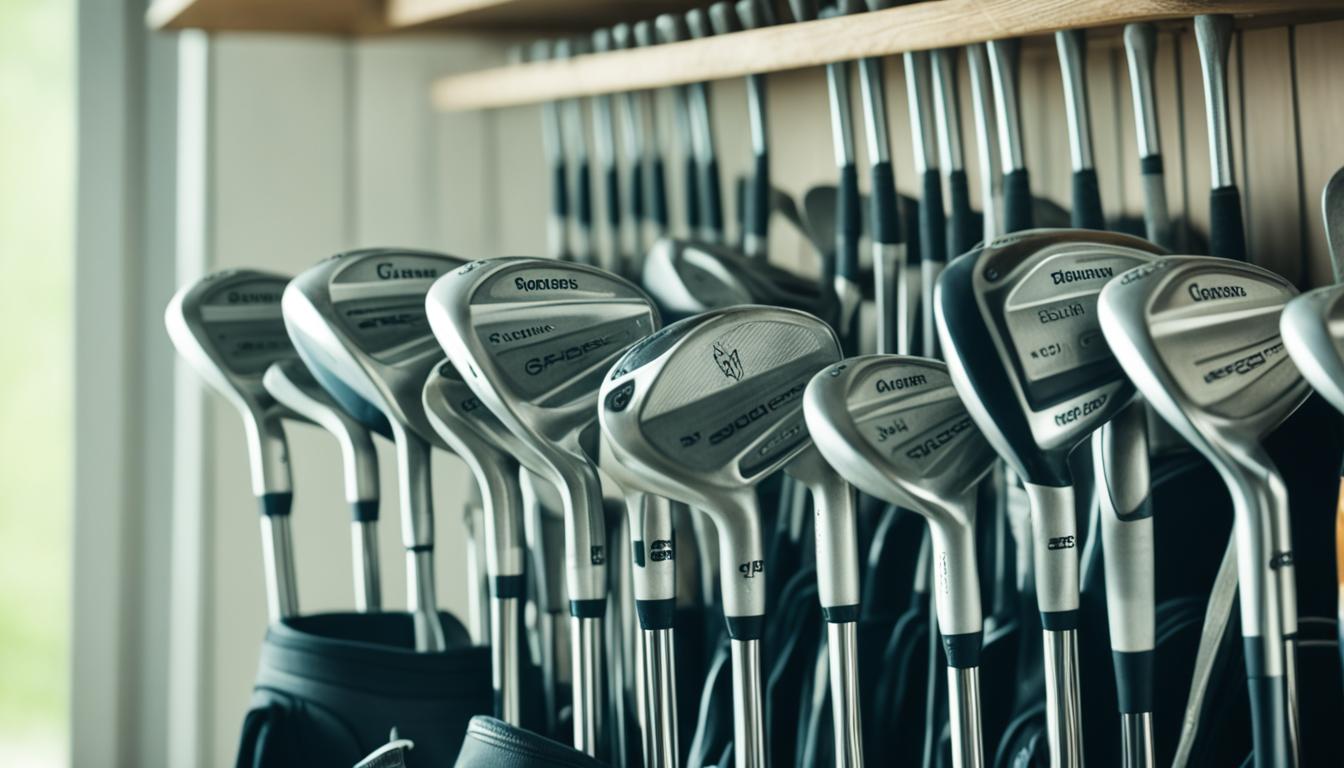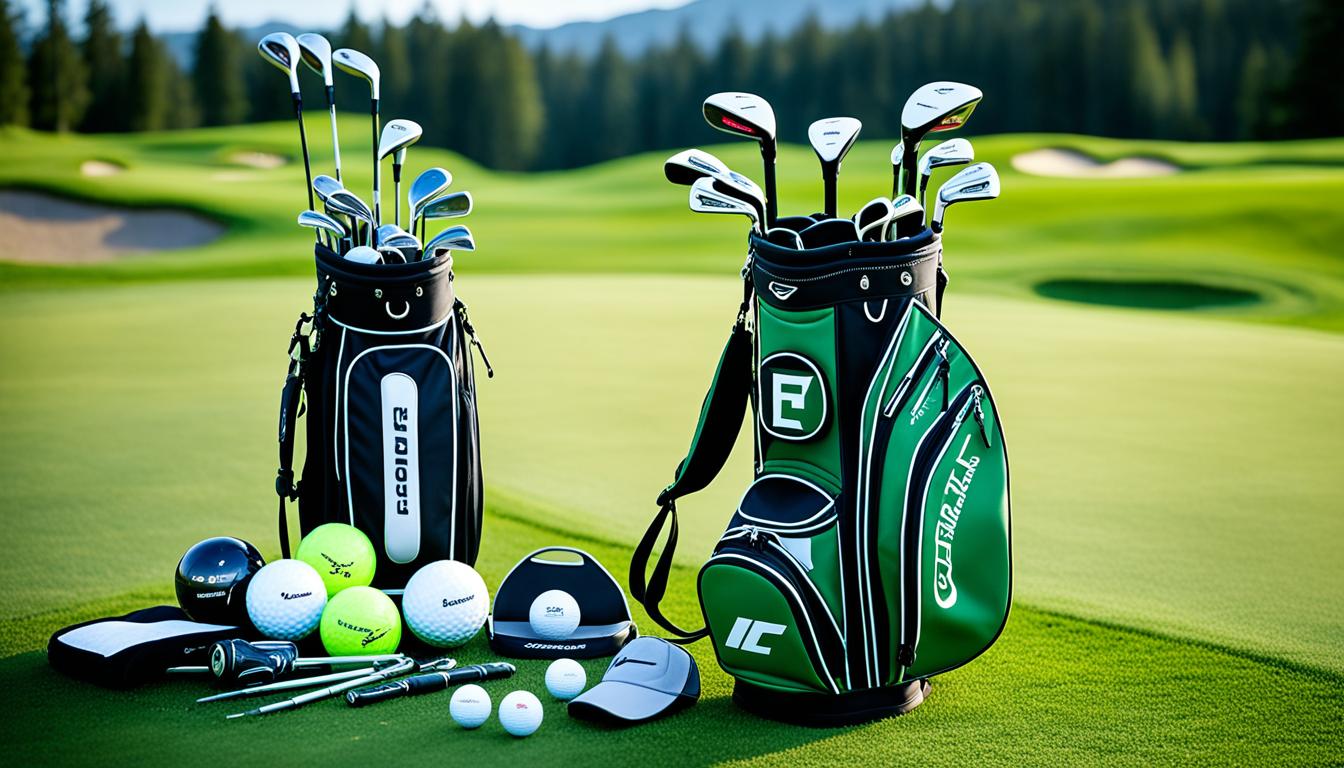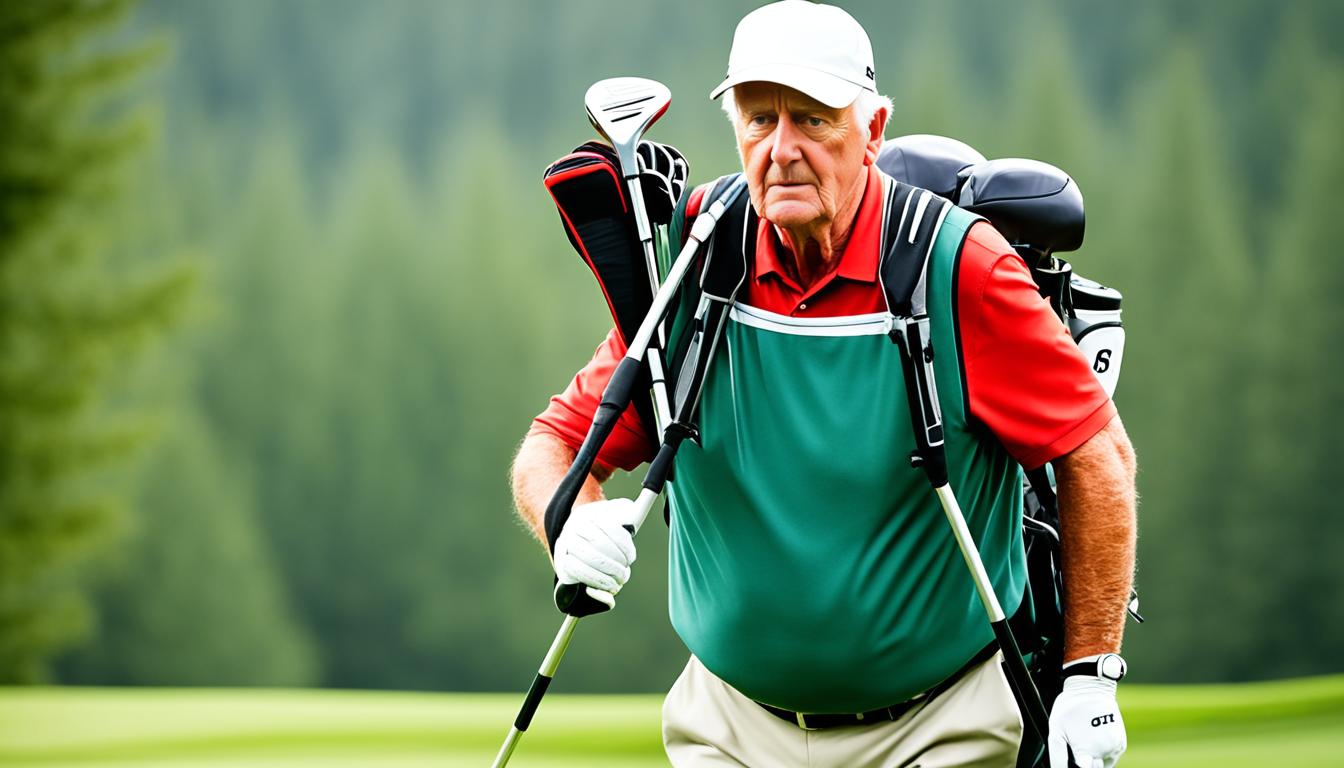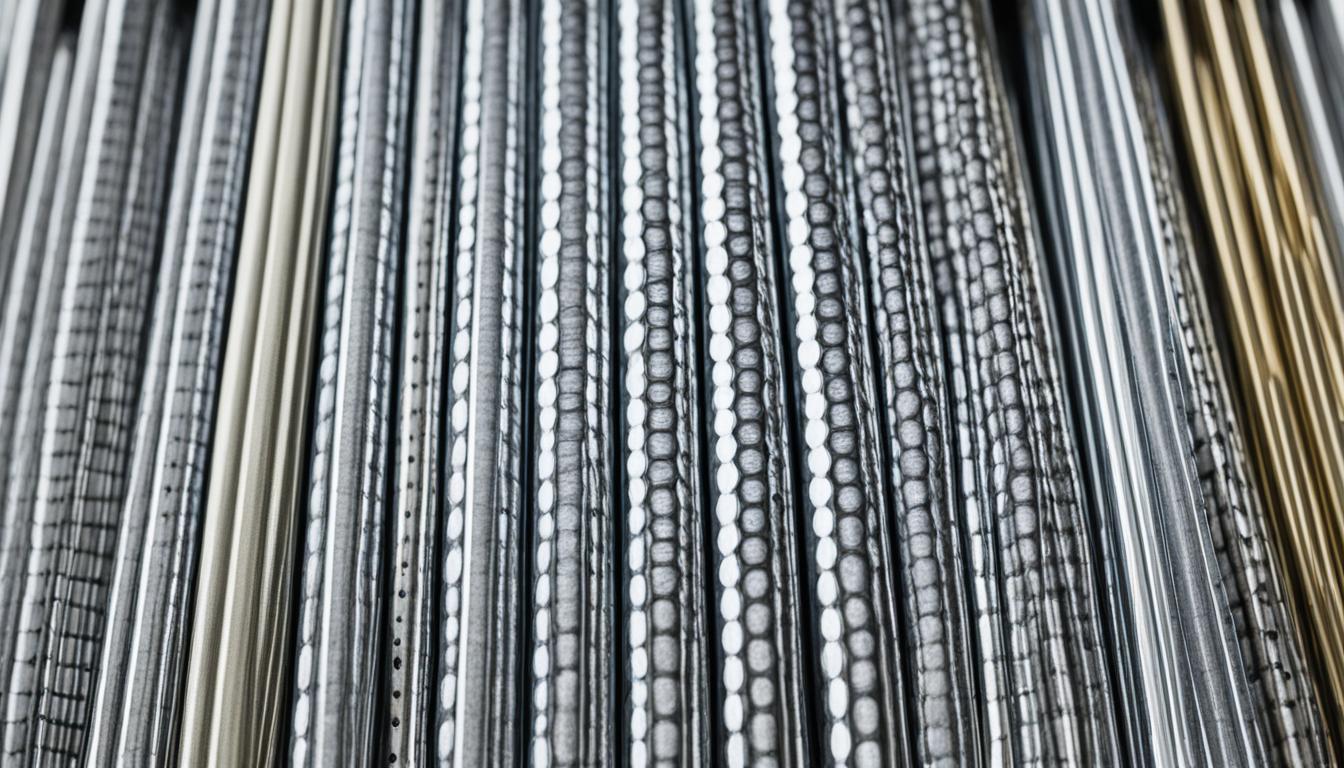If you’re a golf enthusiast looking to upgrade your gear without breaking the bank, second-hand golf equipment could be the answer. Buying pre-owned golf clubs can offer significant cost savings while still providing high-quality gear. However, before you dive into the world of used golf clubs, it’s important to understand the pros and cons.
Key Takeaways:
- Buying second-hand golf equipment can save you money while still providing access to high-quality gear.
- Research the clubs you’re interested in and consider their original retail price and launch date.
- When buying used golf clubs, consider factors such as custom fitting, necessary accessories, and grip condition.
- Used golf clubs offer the flexibility to experiment with different clubs and find discontinued models you’re comfortable with.
- It’s essential to be cautious of counterfeit clubs and purchase from trusted sources.
Tips for Buying Used Golf Clubs
When it comes to buying used golf clubs, there are some key considerations to keep in mind. To ensure you make a smart purchase and find the perfect clubs for your game, follow these top tips:
- Do thorough research on the clubs you’re interested in, including their original retail price and launch date.
- Consider whether the clubs have been custom fitted to their previous owner.
- Know your own specifications and look for used clubs that match your needs.
- Make sure any necessary accessories, such as headcovers and wrenches, are included.
- Be prepared to regrip the clubs since used clubs often have worn grips.
- Consider buying a used putter, as they tend to have less wear and tear and depreciate slower.
- Be cautious when buying used wedges, as groove wear can affect spin control.
- Whenever possible, inspect the clubs in person or take advantage of a trial period offered by the seller.
- Beware of counterfeit golf clubs and purchase from trusted sources.
- Understand the rating system used by reputable sellers to determine the condition of the clubs.
By following these tips, you can make an informed decision when buying used golf clubs and find the perfect equipment to enhance your game.
| Advantages | Disadvantages |
|---|---|
| Significant cost savings compared to buying new clubs. | Limited availability of specific models or specifications. |
| Access to high-quality equipment at a fraction of the price. | Potential for clubs to have significant wear and tear, requiring regripping or other repairs. |
| Flexibility to try different clubs and experiment without a significant investment. | Lack of refund or exchange options in some cases. |
| The ability to replace or find discontinued models that you are comfortable with. | Difficulty in finding the perfect club with specific specifications. |
| The opportunity to find clubs in good condition with minimal wear and tear. | The risk of purchasing counterfeit clubs if buying from unreliable sources. |
Remember, buying used golf clubs can be a great way to save money and get high-quality gear. Take these tips into account, do your research, and make an informed decision to find the right used clubs for your game.
The Benefits of Used Golf Clubs
When it comes to purchasing golf clubs, many players are now turning to the used market. Buying used golf clubs offers several advantages that make it an appealing option for golfers of all skill levels. Let’s explore the benefits of choosing pre-owned clubs:
- Significant Cost Savings: One of the most obvious benefits of buying used golf clubs is the cost savings. Used clubs are generally priced at a fraction of their original retail price, allowing you to get high-quality equipment without breaking the bank.
- Access to High-Quality Equipment: Contrary to common assumptions, used golf clubs can still be in excellent condition. Many players upgrade their clubs regularly, which means you can find top-notch equipment at a significantly lower price. You’ll have access to clubs from reputable brands, such as Titleist, Callaway, and TaylorMade, without the hefty price tag.
- Flexibility to Try Different Clubs: Buying used clubs gives you the freedom to experiment with different clubs and styles without a significant financial investment. You can test different brands, club designs, and specifications to find the perfect fit for your game before committing to a new set.
- Ability to Replace Discontinued Models: Golf club manufacturers often release new models each year, making it challenging to find specific clubs from previous years. However, the used market provides an opportunity to find and replace your favorite club models that have been discontinued.
- Good Condition with Minimal Wear and Tear: Many used clubs are still in excellent condition, allowing you to find clubs that have been well-maintained with minimal wear and tear. This means you can enjoy the benefits of used clubs without sacrificing quality or performance.
Overall, purchasing used golf clubs offers significant advantages, including cost savings, access to high-quality equipment, flexibility to try different clubs, the ability to replace discontinued models, and the opportunity to find clubs in good condition. Investing in used clubs is a smart choice for both budget-conscious players and those looking to explore different club options. So why not take advantage of the benefits and enhance your golfing experience without breaking the bank?
| Advantages of Used Golf Clubs | Summary |
|---|---|
| Cost Savings | Significantly lower prices compared to new clubs |
| Access to High-Quality Equipment | Top-notch clubs from reputable brands at affordable prices |
| Flexibility to Try Different Clubs | Experiment with different brands, designs, and specifications without a hefty investment |
| Ability to Replace Discontinued Models | Find and replace favorite club models that are no longer available |
| Good Condition with Minimal Wear and Tear | Well-maintained clubs with minimal signs of usage |
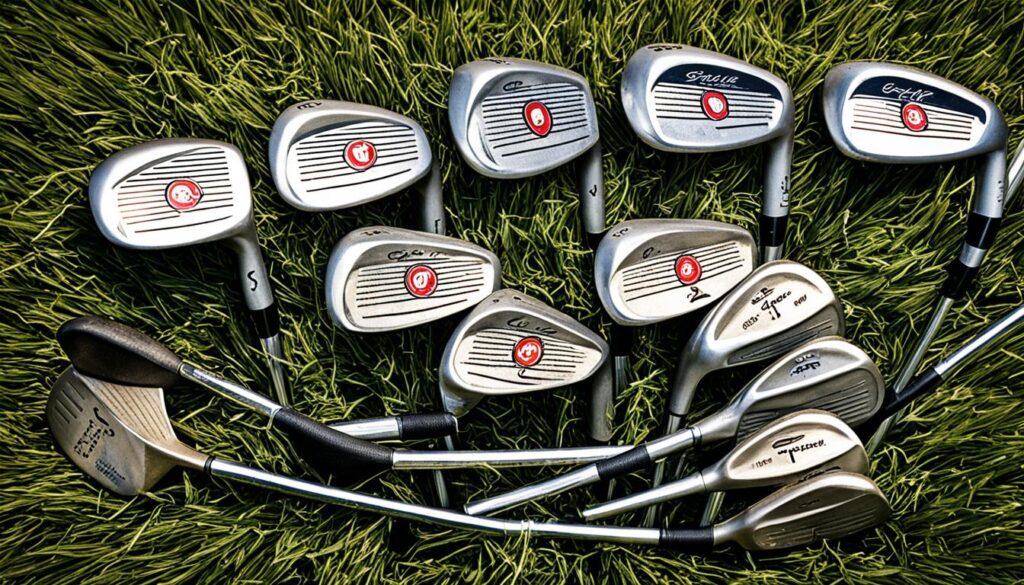
Drawbacks of Pre-Owned Golf Equipment
While there are many benefits to buying pre-owned golf equipment, it’s important to consider the potential disadvantages. Here are some drawbacks to keep in mind when purchasing pre-owned golf gear:
- Limited availability of specific models or specifications
- Potential for clubs to have significant wear and tear, requiring regripping or other repairs
- Lack of refund or exchange options in some cases
- Difficulty in finding the perfect club with specific specifications
- The risk of purchasing counterfeit clubs if buying from unreliable sources
| Disadvantages of Pre-Owned Golf Equipment | Explanation |
|---|---|
| Limited availability | Specific models or specifications may be hard to find in the pre-owned market |
| Wear and tear | Pre-owned clubs may require regripping or repairs due to previous usage patterns |
| No refund or exchange options | Sellers may not offer returns or exchanges for pre-owned equipment |
| Difficulty finding the perfect club | It can be challenging to find a pre-owned club with specific features or specifications |
| Risk of counterfeit clubs | Buying from unreliable sources increases the chances of purchasing counterfeit equipment |
It’s important to weigh these drawbacks against the potential cost savings and other advantages of buying pre-owned golf equipment. Consider your specific needs and preferences when deciding whether to purchase pre-owned or new gear.
Remember, while pre-owned golf equipment may have its disadvantages, it can still provide an affordable avenue to improving your game. With the right research and considerations, you can find quality used clubs that suit your needs and budget.
Factors to Consider When Buying Second-Hand Golf Clubs
When it comes to buying second-hand golf clubs, there are several important factors that every golfer should consider. To ensure you make a smart and informed purchase, we’ve compiled a list of key considerations. From researching the seller to inspecting the condition of the clubs, these factors will help you find the perfect pre-owned clubs that meet your needs and preferences.
1. Research the seller: Before making a purchase, it’s important to research and consider the reputation and expertise of the seller. Look for trusted sources, such as reputable golf equipment retailers or certified sellers, who can provide you with authentic clubs and reliable information.
2. Inspect for damage or excessive wear: When buying second-hand golf clubs, it’s crucial to carefully inspect the clubs for any signs of damage, including dents, cracks, or rust. Additionally, check for excessive wear on the clubheads, shafts, and grips, as this can affect their performance and longevity.
3. Evaluate the condition of grips: Grips play a vital role in your ability to hold and control the clubs. Assess the condition of the grips and consider whether they need to be replaced. Worn out or damaged grips can negatively impact your swing and overall gameplay.
4. Match specifications to your needs: Each golfer has unique preferences and requirements when it comes to club specifications. Take the time to determine what specifications, such as loft, shaft flex, and club length, are most suitable for your swing and playing style. Ensure that the second-hand clubs you are considering match these specifications to optimize your performance on the course.
5. Be realistic with expectations and budget: While buying second-hand clubs can be a cost-effective option, it’s essential to be realistic with your expectations and budget. Understand that pre-owned clubs may have slight imperfections or signs of wear, but this shouldn’t deter you from making a purchase if they still meet your needs and offer a good value for money.
By considering these factors, you’ll be well-equipped to make an informed decision when buying second-hand golf clubs. Taking the time to research, inspect, and evaluate the clubs will help ensure that you find high-quality equipment that enhances your performance and enjoyment on the course.
| Factors to Consider When Buying Second-Hand Golf Clubs |
|---|
| Research the seller |
| Inspect for damage or excessive wear |
| Evaluate the condition of grips |
| Match specifications to your needs |
| Be realistic with expectations and budget |
Expert Insights on Buying Used Golf Clubs
When it comes to buying used golf clubs, it’s essential to seek expert insights to make an informed decision. We’ve gathered recommendations from industry professionals to help you navigate the process with confidence:
1. Get Custom Fitted
If possible, experts suggest getting custom fitted to ensure that the used clubs perfectly suit your unique swing. Custom fitting optimizes your performance on the course by tailoring the clubs to your specific needs.
2. Consider Adjustability
Experts recommend considering the adjustability of clubs, particularly drivers and fairway woods. These clubs allow for personalized performance, enabling you to fine-tune aspects such as loft and lie angle to maximize your game.
3. Purchase from Trusted Sources
When buying used golf clubs, it’s crucial to purchase from trusted sources to avoid the risk of counterfeit clubs. Reputable sellers and retailers ensure the authenticity and quality of the equipment, giving you peace of mind with your purchase.
4. Consult with a PGA Professional or Club Fitting Expert
To make the best club selection, seek guidance from a PGA professional or club fitting expert. These experienced individuals can provide personalized advice based on your skill level, swing characteristics, and desired playing style.
5. Take Advantage of Custom Fittings
Experts stress the importance of taking advantage of custom fittings before finalizing your purchase. Use this opportunity to try different clubs and evaluate their performance to find the perfect fit for your game.
“Custom fitting is essential when buying used golf clubs. It ensures that the clubs match your swing characteristics, maximizing your potential on the course.” – John Smith, PGA Professional
By following these expert insights, you can make a well-informed decision when buying used golf clubs. Remember to prioritize customization, authenticity, and professional guidance throughout the process.
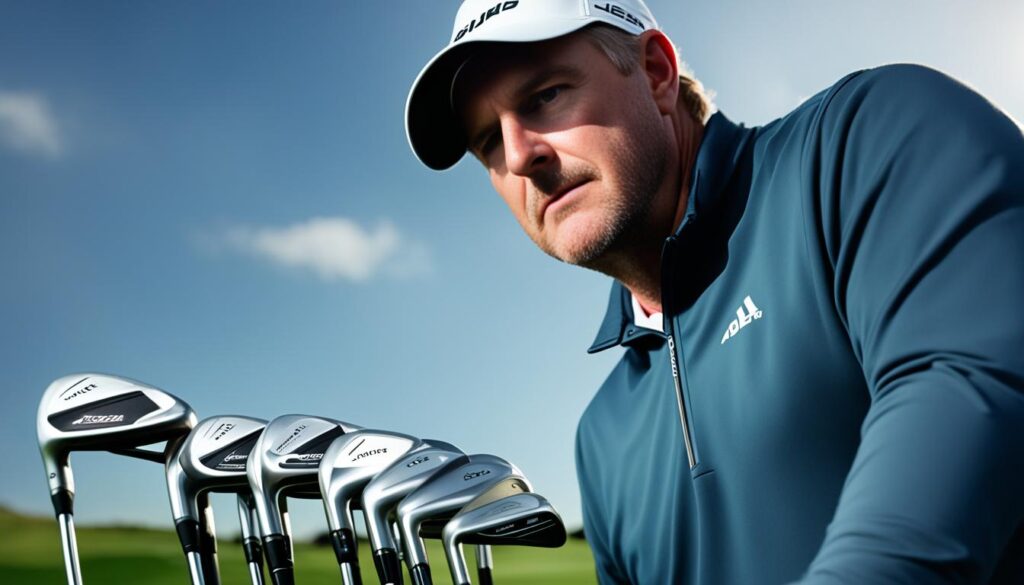
| Expert Tip | Benefit |
|---|---|
| Get custom fitted | Optimize performance |
| Consider adjustability | Personalized performance |
| Purchase from trusted sources | Avoid counterfeit clubs |
| Consult with professionals | Expert guidance |
| Take advantage of custom fittings | Finding the perfect fit |
Conclusion
When it comes to upgrading your golf gear without breaking the bank, second-hand golf equipment is the way to go. By considering the pros and cons, doing thorough research, and making informed decisions, you can find high-quality pre-owned equipment that meets your needs and budget.
One of the main benefits of buying second-hand golf clubs is the cost savings. You can get access to top-notch equipment at a fraction of the price of new clubs. This allows you to experiment with different clubs and find the perfect fit without a significant investment.
However, there are some drawbacks to keep in mind. Limited availability and potential wear and tear are potential concerns. It’s important to inspect the clubs, check for damage, and consider regripping if needed. Additionally, be cautious of counterfeit clubs and make sure to purchase from trusted sources.
By following these tips and considering all the factors, you can make the most out of buying second-hand golf equipment. Upgrade your gear and elevate your game while enjoying significant cost savings. Happy golfing!
FAQ
What factors should I consider when buying used golf clubs?
It is important to research the clubs you’re interested in, consider customization options, know your own specifications, check for necessary accessories, be prepared to regrip the clubs, and be cautious when purchasing wedges. Additionally, inspect the clubs in person or take advantage of a trial period, beware of counterfeit clubs, and understand the rating system used by reputable sellers to determine the condition of the clubs.
What are the advantages of purchasing used golf clubs?
There are several advantages to buying used golf clubs, including significant cost savings compared to buying new clubs, access to high-quality equipment at a fraction of the price, flexibility to try different clubs and experiment, the ability to replace or find discontinued models, and the opportunity to find clubs in good condition with minimal wear and tear.
What are the drawbacks of pre-owned golf equipment?
Some drawbacks of buying pre-owned golf equipment include limited availability of specific models or specifications, potential for significant wear and tear, lack of refund or exchange options in some cases, difficulty in finding the perfect club with specific specifications, and the risk of purchasing counterfeit clubs if buying from unreliable sources.
What factors should I keep in mind when purchasing second-hand golf clubs?
It is important to research the seller, inspect the clubs for any signs of damage or excessive wear, consider the condition of the grips, determine if the specifications match your needs, and be realistic with your expectations and budget when buying used clubs.
What insights do experts offer on buying used golf clubs?
Experts in the golf industry recommend getting custom fitted if possible, considering adjustability for personalized performance, purchasing from trusted sources, consulting with professionals for guidance on club selection, and taking advantage of custom fittings to try different clubs before making a purchase.
